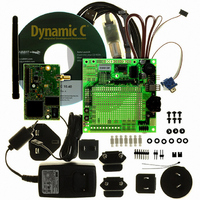101-1173 Rabbit Semiconductor, 101-1173 Datasheet - Page 21

101-1173
Manufacturer Part Number
101-1173
Description
RCM4400W DEV KIT UNIVERSAL
Manufacturer
Rabbit Semiconductor
Series
RCM4400W RabbitCore™r
Type
Wi-Fi / 802.11.br
Datasheet
1.20-101-1202.pdf
(126 pages)
Specifications of 101-1173
Frequency
2.4GHz
Wireless Frequency
58.98 MHz
For Use With/related Products
RCM4400W
Lead Free Status / RoHS Status
Lead free / RoHS Compliant
Other names
316-1133
- Current page: 21 of 126
- Download datasheet (2Mb)
2.3 Run a Sample Program
If you already have Dynamic C installed, you are now ready to test your programming
connections by running a sample program. Start Dynamic C by double-clicking on the
Dynamic C icon on your desktop or in your
menu. Select
Start
Code and BIOS in Flash,
on the “Compiler” tab in the Dynamic C
menu.
Run in RAM
Options > Project Options
Then click on the “Communications” tab and verify that
is
Use USB to Serial Converter
selected to support the USB programming cable. Click
.
OK
Determine which COM port was assigned to the USB programming cable on your PC.
Open
and identify
Control Panel > System > Hardware > Device Manager > Ports
which COM port is used for the USB connection. In Dynamic C, select
Options > Project
Options
, then select this COM port on the
Communications
tab, then click
OK
. You may
type the COM port number followed by
Enter
on your computer keyboard if the COM
port number is outside the range on the dropdown menu.
Now find the WIFISCAN.C sample program in the Dynamic C Samples\TCPIP\
WiFi folder, open it with the File menu, then compile and run the sample program by
pressing F9.
The Dynamic C
STDIO
window will display
, and will display a list
Starting scan....
of access points/ad-hoc hosts as shown here.
The following fields are shown in the Dynamic C
window.
STDIO
• Channel—the channel the access point is on (1–11).
• Signal—the signal strength of the access point.
• MAC—the hardware (MAC) address of access point.
• Access Point SSID—the SSID the access point is using.
OEM User’s Manual
15
Related parts for 101-1173
Image
Part Number
Description
Manufacturer
Datasheet
Request
R

Part Number:
Description:
KIT DEV FOR BL2500 COYOTE
Manufacturer:
Rabbit Semiconductor
Datasheet:

Part Number:
Description:
KIT APPLICATION SIMPLE SENSOR
Manufacturer:
Rabbit Semiconductor
Datasheet:

Part Number:
Description:
KIT DEV RCM5400W US/INTERNATIONL
Manufacturer:
Rabbit Semiconductor
Datasheet:

Part Number:
Description:
DEV KIT DELUXE MINICORE RCM5600W
Manufacturer:
Rabbit Semiconductor
Datasheet:

Part Number:
Description:
KIT FOR BL4S100 STARTER PACKAGE
Manufacturer:
Rabbit Semiconductor
Datasheet:

Part Number:
Description:
DEV KIT STANDARD MINI RCM5600W
Manufacturer:
Rabbit Semiconductor
Datasheet:

Part Number:
Description:
KIT ADD ON WI-FI RCM3400
Manufacturer:
Rabbit Semiconductor
Datasheet:

Part Number:
Description:
KIT MESH NETWORK ADD-ON RCM4510W
Manufacturer:
Rabbit Semiconductor
Datasheet:

Part Number:
Description:
MODULE RABBITCORE RCM3720
Manufacturer:
Rabbit Semiconductor
Datasheet:

Part Number:
Description:
MODULE RABBITCORE RCM3220
Manufacturer:
Rabbit Semiconductor
Datasheet:

Part Number:
Description:
MODULE RABBITCORE RCM3210
Manufacturer:
Rabbit Semiconductor
Datasheet:

Part Number:
Description:
COMPUTER SGL-BOARD OP6600 W/SRAM
Manufacturer:
Rabbit Semiconductor
Datasheet:

Part Number:
Description:
COMPUTER SGL-BD BL2000 SRAM/FLSH
Manufacturer:
Rabbit Semiconductor











